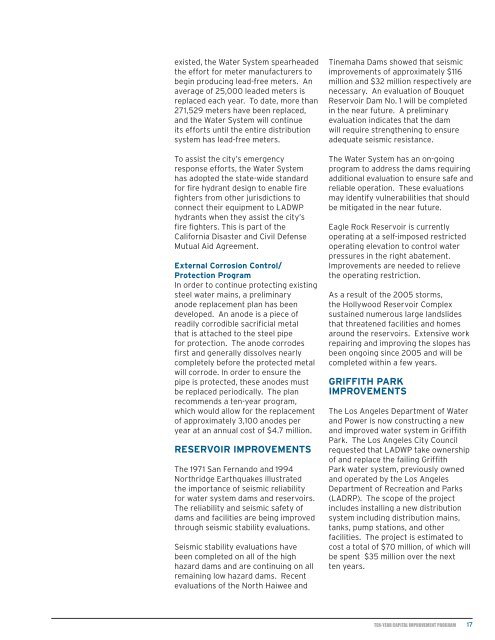TEN-YEAR CAPITAL IMPROVEMENT PROGRAM - LA Differentiated
TEN-YEAR CAPITAL IMPROVEMENT PROGRAM - LA Differentiated
TEN-YEAR CAPITAL IMPROVEMENT PROGRAM - LA Differentiated
Create successful ePaper yourself
Turn your PDF publications into a flip-book with our unique Google optimized e-Paper software.
existed, the Water System spearheaded<br />
the effort for meter manufacturers to<br />
begin producing lead-free meters. An<br />
average of 25,000 leaded meters is<br />
replaced each year. To date, more than<br />
271,529 meters have been replaced,<br />
and the Water System will continue<br />
its efforts until the entire distribution<br />
system has lead-free meters.<br />
To assist the city’s emergency<br />
response efforts, the Water System<br />
has adopted the state-wide standard<br />
for fire hydrant design to enable fire<br />
fighters from other jurisdictions to<br />
connect their equipment to <strong>LA</strong>DWP<br />
hydrants when they assist the city’s<br />
fire fighters. This is part of the<br />
California Disaster and Civil Defense<br />
Mutual Aid Agreement.<br />
External Corrosion Control/<br />
Protection Program<br />
In order to continue protecting existing<br />
steel water mains, a preliminary<br />
anode replacement plan has been<br />
developed. An anode is a piece of<br />
readily corrodible sacrificial metal<br />
that is attached to the steel pipe<br />
for protection. The anode corrodes<br />
first and generally dissolves nearly<br />
completely before the protected metal<br />
will corrode. In order to ensure the<br />
pipe is protected, these anodes must<br />
be replaced periodically. The plan<br />
recommends a ten-year program,<br />
which would allow for the replacement<br />
of approximately 3,100 anodes per<br />
year at an annual cost of $4.7 million.<br />
RESERVOIR <strong>IMPROVEMENT</strong>S<br />
The 1971 San Fernando and 1994<br />
Northridge Earthquakes illustrated<br />
the importance of seismic reliability<br />
for water system dams and reservoirs.<br />
The reliability and seismic safety of<br />
dams and facilities are being improved<br />
through seismic stability evaluations.<br />
Seismic stability evaluations have<br />
been completed on all of the high<br />
hazard dams and are continuing on all<br />
remaining low hazard dams. Recent<br />
evaluations of the North Haiwee and<br />
Tinemaha Dams showed that seismic<br />
improvements of approximately $116<br />
million and $32 million respectively are<br />
necessary. An evaluation of Bouquet<br />
Reservoir Dam No. 1 will be completed<br />
in the near future. A preliminary<br />
evaluation indicates that the dam<br />
will require strengthening to ensure<br />
adequate seismic resistance.<br />
The Water System has an on-going<br />
program to address the dams requiring<br />
additional evaluation to ensure safe and<br />
reliable operation. These evaluations<br />
may identify vulnerabilities that should<br />
be mitigated in the near future.<br />
Eagle Rock Reservoir is currently<br />
operating at a self-imposed restricted<br />
operating elevation to control water<br />
pressures in the right abatement.<br />
Improvements are needed to relieve<br />
the operating restriction.<br />
As a result of the 2005 storms,<br />
the Hollywood Reservoir Complex<br />
sustained numerous large landslides<br />
that threatened facilities and homes<br />
around the reservoirs. Extensive work<br />
repairing and improving the slopes has<br />
been ongoing since 2005 and will be<br />
completed within a few years.<br />
GRIFFITH PARK<br />
<strong>IMPROVEMENT</strong>S<br />
The Los Angeles Department of Water<br />
and Power is now constructing a new<br />
and improved water system in Griffith<br />
Park. The Los Angeles City Council<br />
requested that <strong>LA</strong>DWP take ownership<br />
of and replace the failing Griffith<br />
Park water system, previously owned<br />
and operated by the Los Angeles<br />
Department of Recreation and Parks<br />
(<strong>LA</strong>DRP). The scope of the project<br />
includes installing a new distribution<br />
system including distribution mains,<br />
tanks, pump stations, and other<br />
facilities. The project is estimated to<br />
cost a total of $70 million, of which will<br />
be spent $35 million over the next<br />
ten years.<br />
<strong>TEN</strong>-<strong>YEAR</strong> <strong>CAPITAL</strong> <strong>IMPROVEMENT</strong> <strong>PROGRAM</strong><br />
17





